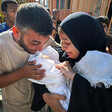Rights and Accountability 14 November 2018

Palestinians celebrate in Gaza City after the declaration of a ceasefire on 13 November.
APA imagesA ceasefire announced on Tuesday brought an end to more than 24 hours of airstrikes across Gaza and a massive barrage of mortars and missiles into southern Israel.
Palestinians held mass rallies across Gaza following the ceasefire:
A large crowd gathered in front of the home of a commander in the armed wing of Hamas who was killed by Israeli undercover forces on Sunday.Demonstrators shouted in praise of the resistance:
Palestinians gathered at the site of the Gaza City building housing Al-Aqsa TV, a broadcaster affiliated with Hamas, before it was reduced to rubble in Israeli airstrikes Monday night: Demonstrators also assembled in Jabaliya in northern Gaza: And in Rafah, southern Gaza: While Palestinians displayed high morale in Gaza, angry demonstrators attempted to shut down roads in southern Israel in protest of the ceasefire.Protesters burned tires on roads in an attempt to shut down traffic:
Some observers likened the tactic to that used by Palestinians during the mass protests held along Gaza’s boundary with Israel over the past several months: Protesters also blocked a road in Tel Aviv but with a different message: Fourteen Palestinians were killed by Israeli fire in Gaza between Sunday night and the declaration of a ceasefire on Tuesday.Seven Palestinian fighters and an Israeli army colonel were killed in the firefight that precipitated the 36 hours of fierce bombing and rocket fire.
Three Palestinian fighters were killed on Monday, including two members of the armed wing of the Popular Front for the Liberation of Palestine.
One of them, Muhammad Zakariya al-Tatari, 27, was among the approximately 1,000 Palestinian refugees who fled to Gaza from Yarmouk camp near Damascus after it became a besieged arena of fighting in the context of the Syrian civil war.
Mousa Iyad Ali Abd al-Al, 22, a fighter with the armed wing of the Palestinian faction Islamic Jihad, died on Monday from injuries sustained in Israeli strikes on Khan Younis the previous night:
On Tuesday morning an Israeli drone fired a missile at a group of civilians in Gaza City, killing Musab Said Asad Hawas, 21, and wounding three others.Khaled Riyad Ahmad al-Sultan, 25, reportedly a civilian, was killed when Israeli forces shelled farmland west of Beit Lahia in northern Gaza on Tuesday morning. An 8-year-old boy was injured by shrapnel in the same incident.
Khaled Maarouf, 29, was killed in an Israeli strike in northern Gaza on Tuesday evening.

Palestinians look at the rubble of a building after an Israeli airstrike in Gaza City on 13 November.
APA imagesOne civilian was killed by rocket fire from Gaza at his home in Ashkelon, a city in southern Israel. The slain man was identified as Mahmoud Abu Asba, a Palestinian in his 40s from the occupied West Bank town of Halhoul.
Israeli media reported that Abu Asba held a work permit and was allowed to stay in Israel overnight.
Israel’s military claimed that some 460 rockets were fired from Gaza over the course of 25 hours, around a quarter of them intercepted by a missile defense system.
“Most of the rest landed in open fields, but dozens landed inside Israeli cities and towns, killing one person, injuring dozens more and causing significant property damage,” the Times of Israel reported.
The Israeli military targeted and destroyed several multi-story buildings in Gaza overnight Monday.
An unnamed senior air force officer, boasting of a new military tactic used at the end of Israel’s 2014 war on Gaza, admitted to the Tel Aviv daily Haaretz that “These are targets of high-rise buildings in city centers.”

An unexploded Israeli rocket in Khan Younis, southern Gaza, on 13 November.
APA imagesThe officer added that “We’ve learned how to attack these targets at the heart of residential neighborhoods and obliterate them without killing anyone in the strike. We uphold our values, we’re not fighting against civilians.”
Civilians across Gaza, one of the most densely populated areas in the world, were terrorized by the bombing in their neighborhoods:
Al Mezan, a human rights group based in Gaza, stated that Israeli occupation forces used “disproportionate force aimed at causing serious damage to the residential surroundings” of targeted civilian installations, “displacing hundreds of families.”The rights group’s own offices were damaged by bombing targeting the nearby al-Amal Hotel in western Gaza City late Monday night:
The five-story al-Amal Hotel building, which housed the Internal Security Service in Gaza, was totally destroyed. Nearby homes and shops were damaged in the attack, as well as telephone and electricity infrastructure.An aerial photo shows a crater where the building once stood:
A drone bombed a five-story residential building in Gaza City belonging to Naji al-Yazji, 51, destroying it and damaging nearby homes and shops.A three-story home belonging to Nasrallah Suleiman al-Barim, 66, was completely destroyed by Israeli warplane bombardment in Bani Suheila, east of Khan Younis.
Homes were also targeted in the areas of Rafah, Beit Lahia, Jabaliya and Deir al-Balah.
More than 250 Palestinians have been killed by Israeli forces in Gaza so far this year, nearly 175 of them during mass protests along the boundary with Israel that began in late March.






Comments
make it right!
Permalink John Costello replied on
That Israelis would be embittered, because they were cheated out of the opportunity to kill more Palestinians, is perfectly natural. If there was a role reversal tomorrow and Palestinians ruled Israelis perhaps not, because Palestinians have learned - through real hardship - to hate death and destruction. But that lesson, which would stay with this generation, would fade with the next because their progeny would lead privileged lives built on the land and the backs of subjects whose humanness they would learn to disregard.
On the other hand, if in fact the roles were magically reversed, Israelis would be forced to go backwards. They would lose their material advantage and military dominance. They would become who they once were, ethnically cleansed refugees in a foreign land; reviled and oppressed but strengthened within. They would learn again that striving for peace and justice, wherever they found themselves, meant contentment, security and a chance to grow inwardly and outwardly by enriching and broadening the societies they touched.
Israeli Jews could, simply by settling for what is only fair and just, by correcting a terrible mistake, by following the ‘Golden Rule’, by doing what only they have the power to do - return to others what they have lost - regain the contentment and security they once cherished. They would - instead of living a terribly destructive delusion that they are no longer refugees in a foreign land – belong.